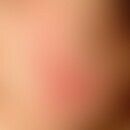Synonym(s)
HistoryThis section has been translated automatically.
DefinitionThis section has been translated automatically.
Crohn's disease is defined as: idiopathic, discontinuous and segmental, chronic inflammatory granulomatous bowel disease of unknown etiology of the entire gastrointestinal tract with preferential localization in the terminal ileum and colon. The entire gastrointestinal tract from mouth to anus may be affected. The disease may present with multiple granulomatous, often painful, ulcerated skin and oral mucosal manifestations.
Complications include stenosis, fistulae, malnutrition (see also Crohn's disease).
You might also be interested in
Occurrence/EpidemiologyThis section has been translated automatically.
Incidence: 6/100.000 inhabitants/year.
EtiopathogenesisThis section has been translated automatically.
Crohn's disease is presumably mediated by autoimmunological processes. In addition to genetic influences (mutations in chromosome 12 and 16 are being discussed - see Crohn's disease below), dietary factors, oral contraceptives, smoking, the intestinal flora and the permeability of the intestinal wall also play a role. Impaired permeability of the mucosa appears to be etiologically significant. Mutations of the so-called NOD receptors are thought to play a pathogenetic role. Initial data suggesting that the disease could be triggered by bacterial antigens appear to be gaining in importance. The main suspect is Mycobacterium avium paratuberculosis (MAP).
Further associations are known, including with the autophagy factor ATG17L1 and the interleukin receptor IL23R.
ManifestationThis section has been translated automatically.
Mostly before the age of 30 with emphasis on the 2nd and 3rd decades of life. Oral mucosal involvement occurs in 4-20% of sufferers.
No sex predilection.
In the relatively rare metastatic Crohn's (Mißnomen), women outnumber men (about 75% of the clientele). The age of manifestation here averages 34.5 years. Children are an extreme exception (20 cases in the world literature).
ClinicThis section has been translated automatically.
Abdominal pain with (usually non-bloody) mucous diarrhea, meteorism, constipation, weight loss. Abdominal pain also appendicitis-like or colicky in the right lower abdomen with a slight increase in temperature.
Classification of the clinic according to the Montreal classification:
- A: Age of manifestation: A1<16years; A2 17-40years; A3>40years.
- L: Localization: L1=Ileum; L2=Colon; L3=ileocolic; L4=upper GI tract
- B: Biological behavior: B1= non-striating/penetrating; B2= striating; B3 internal penetrating; B3p: perianal penetrating
Skin/proximal mucosal manifestations:
- Fistula formations (40%), perianal aphthous ulcerations, anorectal abscesses (25%) - Note: anal fistulas are often the first monitoring signs of enteritis regionalis!
- Acne-like granuloma formations, also chronic abscesses, on the buttocks, lower abdomen and thighs. Occasionally also on the forearms and lower legs. Face mostly free.
- Hidradenitis suppurativa
- Erythema nodosum, erythema exsudativum multiforme, leukocytoclastic vasculitis, palmar erythema, uncharacteristic pustulosis of the skin.
- Persistent genital edema
- Recurrent or permanent, mostly deep, extensive and very painful ulcers in the oral mucosa (4-20% of Crohn's disease cases). Frequency more frequent than with habitual aphthae. They are significantly larger and more painful.
- Chronic, inflammatory, cheilitis granulomatosa-like, plaque formation or swelling of the lips (see below Cheilitis granulomatosa or orofacial granulomatosis; see below illustrations below)
- Coincidences with pyoderma gangraenosum, acrodermatitis enteropathica, Sweet syndrome.
Eyes (7%)
- Episcleritis, iritis, concunctivitis
Joints (20%)
- Occurrence of arthritis and ankylosing spondylitis (80% HLA-B27 positive); sacroilitis
Liver
- Fatty liver, primary sclerosing cholangitis (K83.0)
Growth disorders in children
- Malabsorption syndrome with weight loss
Intestinal stenosis with signs of (sub)ileus, rarely perforations
LaboratoryThis section has been translated automatically.
Specific immunological parameters: pANCA are found in enteritis regionalis (Crohn's disease) in about 20%, in ulcerative colitis in about 65% of cases. Antibodies against yeasts, Saccharomyces cerevisiae, (ASCA) are frequently found in enteritis regionalis, less frequently in ulcerative colitis. Other antibodies are found against tropomyosin in ulcerative colitis, but not in enteritis regionalis.
HistologyThis section has been translated automatically.
DiagnosisThis section has been translated automatically.
Typical endoscopic findings: Disseminated mucosal lesions with often segmental involvement and frequently small bowel involvement.
Histology with epithelioid cell granulomas involving all wall layers.
Small bowel contrast examination according to Sellink with typical findings of stenosis in the terminal ileum.
Floridity can be monitored by the inflammatory parameters among the laboratory values (ESR, CRP, alpha2-globulin, fibrinogen).
Differential diagnosisThis section has been translated automatically.
Tuberculosis, sarcoidosis, ulcerative colitis; acne conglobata.
The main clinical differential diagnoses of the most common granulomatous and non-granulomatous diseases of the skin.
|
Granulomatous
|
Non-granulomatous
|
||
| Disease | Clinical/histological features | Disease | Clinical signs |
| Tuberculosis | Inflammation, caseous necrosis | Pyoderma gangraenosum | Ulceration with probably undermined purple margins |
| Sarcoidosis | Noncaseating granuloma | Behçet's disease | Multiple ulcerations, arthralgia, pathergy |
| Melkersson-Rosenthal syndrome | Non-caseating granuloma | Vulvovaginitis/vaginal infections (venereal and non-venereal, bacterial/fungal) | Ulceration, nodules, swelling, vaginal discharge. |
| Idiopathic granulomatous vulvitis | Non-venereal granuloma | Bartholinitis/Bartholin cyst | Painful swelling of the vulva (labia majora) |
| Foreign body granuloma | Foreign body granuloma | Condylomata acuminata | Exophytic painless lesions |
| Lymphogranuloma venereum | Small, non-hardened ulcers or poplars, inguinal lymph nodes | Hidradenitis suppurativa | Nodular abscess, multiple lesions |
| Syphilis | Solitary painless ulcerations | Rosacea | Pustules, erythema |
| CD1a-positive Langerhans cell histiocytosis with eosinophilia | Shortness of breath, joint pain and arthritis, red bump on skin, hepatomegaly, and dry eyes (asymptomatic in several cases) | vulvar edema / lymphedema | History Post-radiotherapy, neoplastic lymphatic vessel obstruction. |
| Allergic granulomatous reactions | Itchy, more generalized rash: patch test |
Lymphangioma | Swelling |
| Traumatic bleeding | Pressing pain, localized heaviness | ||
TherapyThis section has been translated automatically.
Therapy of skin and mucosal lesions requires parallel treatment of inflammatory bowel disease (first-line therapy: 5-aminosalicylic acid preparations + systemic glucocorticoids.
TNF-alpha blockers(infliximab and adalimumab).
AK against interleukin 10
Vedolizumab (Entyvio®) is a, since May 2014 approved, gut-selective integrin antagonist that can be used in patients with active moderate to severe form of Crohn's disease and ulcerative colitis. Vedolizumab blocks the adhesion molecule alpha4beta7 integrin (see also under integrins).
Surgical therapy for obstruction, perforation, abscess and fistula formation.
Note(s)This section has been translated automatically.
The term "metastatic Crohn's disease" is defined as a sterile, granulomatous, cutaneous lesion without direct connection to the gastrointestinal tract. On the one hand, the term implies a malignant neoplastic process as the underlying disease, on the other hand it is misunderstood that Crohn's disease is a "non-monotopic" granulomatous systemic disease.
Case report(s)This section has been translated automatically.
- Case 1:
- 13-year-old girl with intermittent occurrence of painful, pruritic genito-anal swellings and redness since the 4th LJ. Various unsuccessful pretreatments due to lesions misdiagnosed as erysipelas or contact allergic eczema. Recent occurrence of unformed stools with blood accumulation 2-4 times/day.
- Findings: Slightly reduced AZ, slender EZ and underlying depressed mood. Massive, doughy swelling and redness of the labia majora and partially of the labia minora with dermal infiltration. The area of the rima ani with preference of the perianal region showed erosive, partly derb infiltrated, bulging tumorous efflorescence with smeary coatings and inflammatory component.
- Laboratory: Accelerated ESR, moderate CRP elevation, leukocytosis at 13,000/µl, Hb 10.8 g/dL, decreased corpuscular volume, markedly decreased ferritin level, ASL titer at 1157 U/ml.
- Colonoscopy: Florid Crohn's colitis, histology of terminal ileum with marked lymphofollicular hyperplasia, in coecum and rectum severe chronic inflammatory signs of epithelioid cell granulomas and fissural necrosis.
- Histology of the skin: Chronic lymphedema with fibrosclerosis and abundant ectatic lymphatic vessels. Perivascularly, macrophages including some histiocytic giant cells and collections of epithelioid cellular granulomas associated with vessels were found in addition to loose lympho-plasma cellular infiltration.
- Therapy and course: Initiation of therapy with mesalazine and metronidazole (3 times/day 200 mg p.o.); reduction of stool frequency and healing of genito anal findings. Continued close outpatient care. Recurrence after 2 years. Combination therapy of corticosteroids (prednisolone 50 mg/day p.o.) and metronidazole (dosage see above). Improvement of findings after 3 weeks; continuation of therapy by the attending pediatric clinic.
- Case 2:
- 32-year-old female patient with painful mucosal lesions on the palate for 2 days. The patient's AZ was slightly reduced (fatigue, tiredness, loss of appetite).
- Clinically, there was an oval, painful ulceration on the hard palate on the right side, approximately 0.1 cm in diameter, with a distinct reddened rim. In the area of the soft palate, there were several highly inflammatory "aphthoid" areas measuring approximately 0.3 cm in diameter. The gingiva, the periodontium and the remaining mucosal areas were clinically o.b. A dentogenic cause of the palatal mucosal lesions could be excluded clinically and radiologically.
- Histology of the oral mucosa: Severe, acute ulcerative stomatitis with lymphocytic infiltration as well as few giant cells within the mucosal extravasations; no complete formation of typical epithelioid cell granulomas.
- The specific general examination revealed a hitherto unknown and currently clinically (gastroenterologically) inactive Crohn's disease. Immediate systemic therapy with prednisolone for 5 days and local analgesic rinsing with Bepanthen and Subcutin solutions in alternation led to complete remission within a short time.
LiteratureThis section has been translated automatically.
Antonelli E et al (2021) Dermatological Manifestations in Inflammatory Bowel Diseases. J Clin Med 10:364.
- Crohn BB, Ginzburg L, Oppenheimer GD (1932) Regional ileitis. A pathologic and clinical entity. J Am Med Ass 99: 1323-1329
- Cushing K et al.(2021) Management of Crohn Disease: A Review. JAMA 325:69-80.
- Dalziel TK (1913) Chronic interstitial enteritis. Br Med J 2: 1068-1070
- Djawari DJ (2004) Vulvitis granulomatosa in Crohn's disease. Acta Dermatol 30: 77-80
- Inohara N et al. (2003) Nods: Intracellular proteins involved in inflammation and apoptosis. Nat Rev Immunol 3: 371-382
- Kalmar JR (1994) Crohn's disease: orofacial considerationes and disease pathogenesis. Periodontol 2000 6: 101-115
- Kugathasan S et al. (2003) Dermatologic Manifestations of Crohn Disease in Children: Response to Infliximab. J Pediatr Gastroenterol Nutr 37: 150-154
- Lesniowski A (1903) Przyczynek do chirurgii kiszek. Medycyna (Warsaw) 31: 460-464, 483-489, 514-518
- Mirza MM et al. (2003) Genetic evidence for interaction of the 5q31 cytokine locus and the CARD15 gene in Crohn disease. Am J Hum Genet 72: 1018-1022
- Najarian DJ et al. (2003) Connections betwen psoriasis and Crohn`s disease. JAAD 48: 805-821
- Saalmann R et al. (2009) Orofacial granulomatosis in childhood - a clinical entity that may indicate Crohn`s disease as well as food allergy. Acta Paediatr 98: 1162-1167
- Schneider SL et al. (2018) Cutaneous manifestations of metastatic Crohn's disease. Pediatr Dermatol 35:566-574.
- Tan MH et al. (2001) Improvement of pyoderma gangrenosum and psoriasis associated with Crohn's disease with anti-tumor necrosis factor alpha monoclonal antibody. Arch Dermatol 137: 930-933
- Hambardzumyan M et al (2016) Granulomatous conditions of the vulva. Gynecologic Dermatology. JP Medical Ltd: 121-128
Incoming links (52)
Acrodermatitis enteropathica; Amicrobial intertriginous pustulose; Anal carcinoma; Anal fissure; antimicrobial peptides ; Antisense molecules; Aphthae habituelle; Aphthae habituelle; Autoimmune diseases; Bile acid loss syndrome; ... Show allOutgoing links (23)
Acne conglobata; Acrodermatitis enteropathica; Aphthae habituelle; Cheilitis granulomatosa; Cutaneous tuberculosis (overview); Erythema multiforme, minus-type; Erythema nodosum; Erythema palmare et plantar symptomaticum; Infliximab; Integrins; ... Show allDisclaimer
Please ask your physician for a reliable diagnosis. This website is only meant as a reference.




















